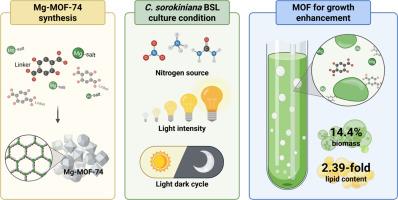镁- mof -74金属镁-有机骨架提高小球藻生物量和脂质产量
IF 6.3
3区 工程技术
Q1 ENGINEERING, CHEMICAL
Journal of the Taiwan Institute of Chemical Engineers
Pub Date : 2025-09-15
DOI:10.1016/j.jtice.2025.106405
引用次数: 0
摘要
背景:金属有机框架(mof)通过控制必需辅因子的释放,为微藻加强CO 2的生物固定提供了有前途的途径。在本研究中,我们研究了镁基MOF (Mg-MOF-74)作为一种功能性营养调节剂对微藻生长动态和生化生产力的影响。Mg-MOF-74由镁节点和2,5-二羟基对苯二甲酸连接物构成,在微藻培养过程中分解,导致镁离子和连接物逐渐释放。方法:以国产小球藻(Chlorella sorokiniana BSL)为研究对象,在不同的氮源和光照条件下进行培养,确定Mg-MOF-74的最佳浓度。在受控的光生物反应器设置下,评估了生物质产量以及淀粉、蛋白质和脂质含量。此外,还对Mg-MOF-74施用前后进行了表征,以评价其在栽培过程中的结构变化和养分释放情况。重要发现:氮对藻类培养至关重要,使用尿素作为氮源时,菌株BSL的生物量最高,达到3.36 g/L,比铵提高1.3倍。与未经处理的对照组相比,添加50 ppm Mg-MOF-74 (CO₂含量为1%)导致生物量增加14.4%,脂质积累增加2.39倍。与单独添加镁盐或有机连接剂(H₄DOBDC)相比,Mg-MOF-74提供了更平衡和持续的养分释放。这种受控的分解增强了碳分配,促进了良好的生化特征。因此,mof辅助的养分输送可以微调辅助因子的有效性,提高光合效率,并最终支持微藻系统中高价值生物产品的生产。本文章由计算机程序翻译,如有差异,请以英文原文为准。

Enhancing biomass and lipid production in Chlorella sorokiniana via magnesium metal-organic framework of Mg-MOF-74
Background
: Metal–organic frameworks (MOFs) offer promising avenues for enhancing CO₂ biofixation in microalgae by enabling the controlled release of essential cofactors. In this study, we investigate the use of magnesium-based MOF, Mg-MOF-74, as a functional nutrient modulator to influence microalgal growth dynamics and biochemical productivity. Mg-MOF-74 is constructed from magnesium nodes and 2,5-dihydroxyterephthalic acid linkers, and decomposed during the microalgal cultivation, leading to the gradual release of both magnesium ions and linkers.
Methods
: A domestic microalgal strain, Chlorella sorokiniana BSL, was cultured under varying conditions, including nitrogen sources and light intensity to determine the optimal concentration of Mg-MOF-74. The biomass yield, as well as starch, protein, and lipid contents, were assessed under controlled photobioreactor settings. Additionally, Mg-MOF-74 was characterized both before and after its application to evaluate structural changes and nutrient release profiles during cultivation.
Significant findings
: Nitrogen is critical for algal culture where the highest biomass of strain BSL was achieved using urea as the nitrogen source, up to 3.36 g/L that is ra 1.3-fold improvement over ammonium. Supplementation with 50 ppm Mg-MOF-74 under 1 % CO₂ led to a 14.4 % increase in biomass and a 2.39-fold enhancement in lipid accumulation compared to untreated controls. Compared to the addition of magnesium salt or the organic linker (H₄DOBDC) alone, Mg-MOF-74 provided a more balanced and sustained release of nutrients. This controlled decomposition enhanced carbon partitioning and promoted a favorable biochemical profile. As a result, MOF-assisted nutrient delivery can fine-tune cofactor availability, improve photosynthetic efficiency, and ultimately support the production of high-value bioproducts in microalgal systems.
求助全文
通过发布文献求助,成功后即可免费获取论文全文。
去求助
来源期刊
CiteScore
9.10
自引率
14.00%
发文量
362
审稿时长
35 days
期刊介绍:
Journal of the Taiwan Institute of Chemical Engineers (formerly known as Journal of the Chinese Institute of Chemical Engineers) publishes original works, from fundamental principles to practical applications, in the broad field of chemical engineering with special focus on three aspects: Chemical and Biomolecular Science and Technology, Energy and Environmental Science and Technology, and Materials Science and Technology. Authors should choose for their manuscript an appropriate aspect section and a few related classifications when submitting to the journal online.

 求助内容:
求助内容: 应助结果提醒方式:
应助结果提醒方式:


